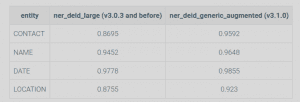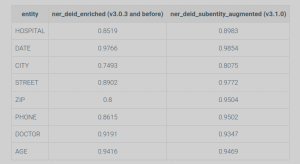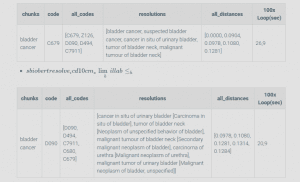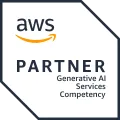Spark NLP - Natural Language Processing in Healthcare
TL'DR
Spark NLP is a state-of-the-art Natural Language Processing library built on top of Apache Spark. It provides simple, performant & accurate NLP annotations for machine learning pipelines that scale easily in a distributed environment. Spark NLP is the only open-source NLP library in production that offers advanced transformers like BERT, CamemBERT, ALBERT, and many others. It supports Python, R, and the JVM ecosystem (Java, Scala, Kotlin) and scales natively with Apache Spark.
- Improved load time & memory consumption for SentenceResolver models
- New JSL Bert Models.
- JSL SBert Model Speed Benchmark.
- New ICD10CM resolver models.
- New Deidentification NER models.
- New column returned in DeidentificationModel
- New Reidentification feature
- New Deidentification Pretrained Pipelines
- Chunk filtering based on confidence
- Extended regex dictionary functionality in Deidentification
- Enhanced RelationExtractionDL Model to create and identify relations between entities across the entire document
- MedicalNerApproach can now accept a graph file directly.
- MedicalNerApproach can now accept a user-defined name for log file.
- More improvements in Scaladocs.
- Bug fixes in Deidentification module.
- New notebooks
What Is Spark NLP for healthcare?
Spark NLP for Healthcare is a specialized extension of the Spark NLP library tailored for healthcare and clinical text processing. This library offers over 2,200 pre-trained models and pipelines designed for medical data, providing precise information extraction, named entity recognition (NER) for clinical and medical concepts, and advanced text analysis. Continuously updated with the latest algorithms, it aims to streamline information processing and equip healthcare professionals with deeper insights from unstructured medical data sources, including electronic health records, clinical notes, and biomedical literature.
It plays a crucial role in clinical assertion detection by analyzing text chunks and applying configurable rules, prefix and suffix patterns, and exception patterns to classify assertions accurately.
Spark NLP for Healthcare is an advanced extension of the Spark NLP library, specifically designed to address the complex needs of the healthcare industry. It leverages state-of-the-art natural language processing (NLP) technologies to extract and analyze information from unstructured medical data, such as clinical notes, medical records, and research papers. By incorporating models tailored for medical terminologies and contexts, Spark NLP for Healthcare enables tasks like entity recognition, de-identification, assertion status detection, and relationship extraction. This helps healthcare organizations improve patient care, enhance research capabilities, and ensure compliance with regulations like HIPAA by providing accurate, scalable, and efficient text processing solutions.
Features Of Spark NLP 5.4.0
Text Preprocessing
Text Preprocessing in Spark NLP encompasses a wide array of techniques and tools designed to prepare text data for analysis. This includes fundamental tasks such as tokenization, which breaks down text into individual tokens, and trainable word segmentation to effectively handle languages with complex word boundaries. The library also features stop words removal to filter out common but non-informative words, token normalization and document normalization to standardize tokens and documents, and document & text splitting to manage large texts. Additionally, stemming and lemmatization are available to reduce words to their root forms, while NGrams and regex matching provide advanced text processing capabilities.
Parsing and Analysis
For parsing and analysis, the library includes chunking to identify and classify text segments, date matcher for recognizing date formats, sentence detector and deep sentence detector (using deep learning techniques) for accurate sentence segmentation, and dependency parsing (both labeled and unlabeled) to understand grammatical relationships. SpanBertCorefModel handles coreference resolution, part-of-speech tagging classifies word roles, and named entity recognition (using deep learning) extracts key medical and clinical entities. Unsupervised keyword extraction and language detection (supporting up to 375 languages) further enhance text analysis capabilities.
Sentiment and Classification
The library offers sentiment detection (using machine learning models), multi-class and multi-label sentiment analysis (using deep learning), and zero-shot NER and zero-shot text classification powered by transformers.
Embeddings
Embeddings play a crucial role with support for various models including Word Embeddings (GloVe and Word2Vec), Doc2Vec, and numerous BERT-based embeddings (including DistilBERT, CamemBERT, RoBERTa, DeBERTa, XLM-RoBERTa, Longformer, ALBERT, XLNet, ELMO, Universal Sentence Encoder, INSTRUCTOR, E5, MPNet, UAE, and OpenAI embeddings). Sentence and chunk embeddings are also supported, along with models for classification and question answering like BERT, DistilBERT, CamemBERT, ALBERT, RoBERTa, DeBERTa, XLM-RoBERTa, Longformer, MPNet, and XLNet.
Machine Translation and Generation
For machine translation and generation, Spark NLP provides Neural Machine Translation (MarianMT), the many-to-many multilingual translation model (Facebook M2M100), Table Question Answering (TAPAS), Text-To-Text Transfer Transformer (Google T5), Generative Pre-trained Transformer 2 (OpenAI GPT-2), Seq2Seq for NLG and translation (Facebook BART), and chat and conversational LLMs (Facebook Llama-2).
Image and Speech
Image and speech processing capabilities include Vision Transformer (Google ViT), Swin Image Classification (Microsoft Swin Transformer), ConvNext Image Classification (Facebook ConvNext), Vision Encoder-Decoder for image-to-text tasks, zero-shot image classification (OpenAI CLIP), and Automatic Speech Recognition (Wav2Vec2, HuBERT, OpenAI Whisper).
Integration and interoperability
Integration and interoperability features include seamless integration with ONNX, OpenVINO, and TensorFlow, as well as full compatibility with Spark ML functions and GPU support. The library offers access to over 31,000 pre-trained models and 6,000 pre-trained pipelines across more than 200 languages.
Multi-Lingual Support
Multi-lingual NER models support a broad range of languages including Arabic, Bengali, Chinese, Danish, Dutch, English, Finnish, French, German, Hebrew, Italian, Japanese, Korean, Norwegian, Persian, Polish, Portuguese, Russian, Spanish, Swedish, Urdu, and more.
- Add a new section after features of spark NLP 5.4.0, “What Is New In Spark NLP 5.4.0?” and add H2 tag.
Enhanced Model Loading
Spark NLP now supports loading multiple models from the same annotator simultaneously, allowing for greater flexibility and efficiency in model management.
README and Website Updates
The README has been revised for improved clarity, and additional pages have been added to the website for better documentation and user guidance.
Stop IDs List
New functionality has been introduced to allow the use of a stop IDs list, enabling users to halt text generation in Phi, Mistral, and Llama annotators.
What’s New in Spark NLP 3.1.0?
Annotators
The new Spark NLP 3.1.0 comes with over 2600+ new pre-trained models and pipelines in over 200+ languages. The new DistilBERT, RoBERTa, and XLM-RoBERTa annotators support HuggingFace (Auto-encoding) models in Spark NLP and extend support for new Databricks and EMR instances. Some new featured Transformers models are:[caption id="attachment_10429" align="aligncenter" width="687"]

Src: https://nlp.johnsnowlabs.com/docs/en/licensed_release_notes[/caption]The new annotators set the stage for state-of-the-art autoencoding models for Natural Language Processing (NLP).
New John Snow Labs sBert models
The new release includes sBert models in TF2 and is fine-tuned on MedNLI, NLI and UMLS datasets with various parameters to cover common NLP tasks in the medical domain.[caption id="attachment_10430" align="alignnone" width="673"]

John Snow Labs sBert models[/caption]The new annotators set the stage for state-of-the-art autoencoding models for Natural Language Processing (NLP).
- DistilBERT: Pre-trained language models are usually computationally expensive, so it is difficult to efficiently execute them on resource-restricted devices. Spark NLP now supports BERT models designed for knowledge distillation. The main idea behind knowledge distillation is to simplify these large (teacher) models into smaller yet almost as efficient and more production-friendly (student) models.
- RoBERTaEmbeddings annotator: RoBERTa (Robustly Optimized BERT-Pre Training Approach) models deliver state-of-the-art performance on NLP/NLU tasks and a sizable performance improvement on the GLUE benchmark. With a score of 88.5, RoBERTa reached the top position on the GLUE leaderboard
- XlmRoBERTaEmbeddings annotator: XLM-RoBERTa (Unsupervised Cross-lingual Representation Learning at Scale) is a large multi-lingual language model, trained on 2.5TB of filtered CommonCrawl data with 100 different languages. It also outperforms multilingual BERT (mBERT) on a variety of cross-lingual benchmarks, including +13.8% average accuracy on XNLI, +12.3% average F1 score on MLQA, and +2.1% average F1 score on NER. XLM-R performs particularly well on low-resource languages, improving 11.8% in XNLI accuracy for Swahili and 9.2% for Urdu over the previous XLM model.
Sentence Resolver Models with better load time improvement
All the Sentence Resolver models in Spark NLP now have faster load times. The new models are about 6X times faster compared to previous versions. Additionally, the load process takes up lesser memory and reduces the chances of Out of Memory (OOM) errors during runtime. This will have a direct effect on reducing your systems’ hardware requirements.
New John Snow Labs sBert models
The new release includes sBert models in TF2 and is fine-tuned on MedNLI, NLI and UMLS datasets with various parameters to cover common NLP tasks in the medical domain.[caption id="attachment_10430" align="alignnone" width="673"]

John Snow Labs sBert models[/caption]
Additional Improvements in the sBert Models
- Full utilization of accelerated hardware GPUs, through migration from MarianTransformer to BatchAnnotate
- Implementation of a new BPE tokenizer for RoBERTa and XLM models. This tokenizer will use the custom tokens from Tokenizer or RegexTokenizer and generates token pieces, encodes, and decodes the results
- Additional support for new Databricks runtimes to Spark NLP
- Additional support for EMR 6.3.0
Chunk Filtering based on Confidence
The new update has a brand new annotator for loading a CSV with both the required entities and confidence thresholds - this is the ChunkFiltererApproach. This annotator will produce a ChunkFilterer model and let users filter models with a specified level of confidence and for a specific treatment.
New Notebooks
Along with all the updates, John Snow Labs has also released a new notebook to help the medical systems reproduce their peer-reviewed NER paper. The notebook also contains several databricks case study notebooks that show examples of how to work with oncology notes dataset and OCR on databricks.
Application-based Feature Improvements
Apart from the technical improvements and model additions in the new release, Spark NLP also has a lot of the improvements in features that are user experience-oriented and would make several day-to-day challenges in Healthcare NLP easier for any use case. Most use cases in healthcare NLP deal with extracting information from unstructured medical data. This new release has made this a lot easier and sophisticated with its newly added features.
Masking and Re-identifying PHI
This is a major part of the application-based features in the recent release. Masking personal data is a vital requirement of Healthcare analytics. Full end-to-end masking of PHI is available at a more granular level and goes to identify and de-identify as many as 23 entities. This feature till now was limited to deidentification. But it now comes with re-identification of masked data at ease in the latest release. The improvement metrics from the previous versions are listed below.


Extracting ICD codes from synonyms
New sBERT models can offer more accurate ICD10 code extraction functionalities. These models are fine-tuned on MedNLI, NLI and UMLS, and a few other datasets. Previously, only entity-specific predictions of disease code were possible through NLP. Given the benchmarks released for these sBERT models, very specific ICD10 codes (for e.g., cancer, bladder cancer, liver cancer, etc.) can be now extracted, i.e., different categories and subcategories of a disease can be easily detected now. Healthcare data scientists can now extract ICD10 codes from fairly unstructured sentences, even when the entities cannot be directly detected from the synonyms.

Entity Relation Extraction from Multiple sentences
Previously only relationships between two or more entities in a sentence was possible. With the new release, related entities across different sentences all over the document can now be extracted. This optimizes any relationship features on the document level. This can be applied to all existing Healthcare models for optimal information extraction. A new option has been added to RENerChunksFilter to support pairing entities from different sentences using .setDocLevelRelations(True), to pass to the Relation Extraction Model.This sums up the latest features released by John Snow Labs in the latest update of Spark NLP. There are many other minor changes in this update. To read more about these updates read the official release notes of Spark NLP 3.1.0.Spark NLP was always reckoned among the best NLP solutions in the Healthcare Analytics industry. With the release of Spark NLP 3.1.0, it has only reinforced its ‘state-of-the-art’ proposition.



.avif)



.png)
.png)
.png)
.png)
.png)
.png)












